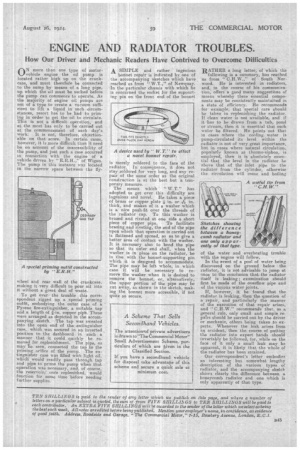• ENGINE AND RADIATOR TROUBLES.
Page 29

If you've noticed an error in this article please click here to report it so we can fix it.
How Our Driver and Mechanic Readers Have Contrived to Overcome Difficulties
1.-IN more than one type of motorNs/vehicle engine the oil pump is located rather high up on the crankcase, and must therefore be connected to the sump by means of a long pipe, up which the oil must be sucked before the pump can commence to operate. As the majority of engine oil pumps are not of a type to create a vacuum Sufficient to lift a liquid in such circumstances, resort has to be had to priming in order to get the oil to circulate. This is not a difficult operation, and at the most has only to be carried out at the commencement of each day's work. It is not, therefore, objectionable on that score. In certain cases, however, it is more difficult than it need be on account of the inaccessibility of the pump, and just such a case occurred in connection with the engine of a vehicle driven by " E.R.H.," of Wigan. The pump in this instance was located in the narrow space between the fly
wheel and rear wail of the crankcase, making it very difficult to pour oil into it without a great deal of waste.
To get over the trouble this correspondent rigged up a special priming outfit, embodying the outer case of a Pyrene fire-extinguisher, a suitable tap
and a length of copper pipt. These were arranged as depicted in the accompanying sketch. The tap was sweated into the open end of the extinguisher case, which was secured in an inverted , position to the dashboard in such a manner that it could quickly be removed for replenishment. The pipe, as may be seen, connected the tap to the priming orifice of the pump. The extinguisher case was filled with light, oil, which would readily pass through tap mid pipe to prime the pump when that operation was necessary, and, of course, the reservoir, once replenished, would function for some time before needing further supplies, A SIMPLE and rather ingenious
bonnet repair is indicated by one of the accompanying sketches which have reached us from " W.T.," of Newquay. In the particular chassis with which he is concerned the socket for the supporting pin on the front end of the bonnet
is merely soldered to the face of the radiator. In consequence, it does not stay soldered for very long, and any repair of the same order as the original construction is at the best but a temporary measure.
The means which " W.T." has adopted to get over this difficulty are ingenious and novel. He takes a piece
of brass or copper plate in. or 73,7. in. thick, and makes of it a washer which is a nice push-fit over the threads of the radiator cap. To this washer is brazed and riveted at one side a short piece of copper pipe.. To facilitate brazing and riveting, the end of the pipe upon which that operation is carried out is flattened and spread, so as to give a better area of contact with the washer. It is necessary also to bend the pipe so that its outer end shall, when the washer is in place on the radiator, be in tine with the bonnet-supporting pin which it is designed to accommodate. The pipe may be left whole, in which case it will be necessary to remove the washer when it is desired to remove the bonnet, or, alternatively, the upper portion of the pipe may be cut away, as shown in the sketch, making the bonnet more accessible, if not quite so secure.
RATHER a long letter, of which the
following is a summary, has reached us from ` C.H.W.," of South Norwood. He is interested in radiators, and, in the course of his communication, offers a good many suggestions of means whereby these essential components may be consistently maintained in a state Of efficiency. He recommends for example, that special tare should be taken in replenishing the radiator. If clean water is not available, and if it has to be drawn from a tub, pond or stream, then it is essential that such water be filtered. He points out that in cases where the cooling water is pump-circulated its level within the radiator is not of very great importance, but in cases where natural circulation, popularly known as thermo-siphon, is employed, then it is absolutely essential that the level in the radiator be above that of the inlet pipe to the radiator from the cylinder, otherwise the circulation will cease and boiling
of the water and overheating trouble with the engine will follow. In the event of a pool of water being discovered on the ground below the radiator, it is not advisable to jump at once to the conclusion that the radiator itself is leaking ; examination should first be made of the overflow pipe and of the various water joints.
If, however, it be found that the radiator is leaking, then the question of a repair, and particularly the manner of the execution of. that repair arises, and " C.H.W." recommends that, as a general rule, only small and simple repairs should be carried out by the driver or mechanic, others being taken to experts. Whenever the leak arises from an accident, then the course of putting the radiator into expert hands should invariably be followed, for, while on the face of it only a small leak may be apparent, it is likely that the whole of the radiator has been strained.
Our correspondent's letter embodies an interesting but somewhat lengthy description of the various types of radiator, and the accompanying sketch shows clearly the difference between a honeycomb radiator and one which is only apparently of that type.






























